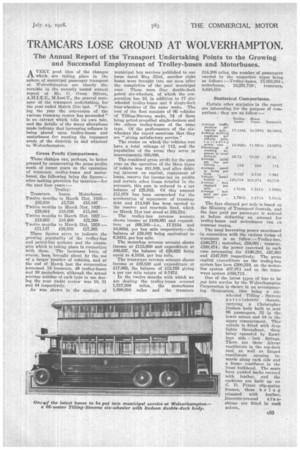TRAMCARS LOSE GROUND AT WOLVERHAMPTON.
Page 57

If you've noticed an error in this article please click here to report it so we can fix it.
The Annual Report of the Transport Undertaking Points to the Growing and Successful Employment of Trolley-buses and Motorbuses.
A VERY good idea of the changes
which are taking place in the sphere of municipal passenger transport at 'Wolverhampton are clearly discernible in the recently issued annual report of Mr. C. Owen Silvers, A.M.I.E.E., M.Inst.T., the general manager of the transport undertaking, for the year ended March 31st last "During the year the conversion of the various tramway routes has proceeded" is an extract which tells it ewn tale. and the details of the many alterations made indicate that increasing reliance is being placed upon trolley-buses and motorbuses for meeting the transport needs of the districts in and adjacent to Wolverhampton.
Gross Profit Comparisons.
These changes can, perhaps, be better grasped by enumerating the gross profits made of recent years on the operation of tramcars, trolley-buses and motorbuses, the following being the figures— after making provision for taxation—for the past four years :— ' Trolley Tramcars. buses. Motorbuses. Twelve months to March 31st, 1925- , 132,638 £5,726 £15,047 Twelve months to March 31st, 1926: £28,684 £10,836 115,085 Twelve months to March 31st, 1927:— £18,603 £10,408 £22,200 Twelve months to March 31st, 1928 :— £11,147 1.39,502 . £27,262 These figures serve to indicate the growing popularity of the trolley-bus and petrol-bus systems and the expansion which is taking place in connection with them. The increases have, of course, been brought about by the use of a larger number of vehicles, and at the end of March last the corporation possessed 10 tramcars, 49 trolley-buses and 50 motorbuses, although the actual average number of each type in use during the year under review was 10, 31 and 44 respectively..
As was shown in the analYsis of municipal bus services published in our issue dated May 22nd, another eight buses were brought into use soon after the completion of the past municipal year. These were Guy double-deck petrol six-wheelers, of which the corporation has 10, iu addition to 17 sixwheeled trolley-buses and 8 single-deck four-wheelers of the same make. The rest of the fleet consists of 66 vehicles of Tilling-Stevens make, 34 of them being petrol-propelled single-deckers and the others trolley-buses of the same type. Of the performance of the sixwheelers the report mentions that they are "giving satisfactory service."
The routes on which the vehicles run have a total mileage of 112, and the population of the areas they serve is approximately 350,000.
• The combined gross profit for the past year on the operation of the three types of vehicle was £81,889, and after debiting interest on capital, repayment of loans, reserve for income-tax on profits and certain other items detailed in the accounts, this stint is reduced to a net balance of £25,919. Of this amount /11,079 has been earmarked for the acceleration of repayment of tramway debt and £14,840 has been carried to the reserve and renewals fund, which on March 31st last stood at £38,524.
The trolley-bus revenue account shows income at £108,891 and expendititre at £69,389—i.e., 17.215d. and 10.968d. per bus mile respectively—the balance of £39,502 being equivalent to 6.247d. per bus mile.
The motorbus revenue account shows income at £115,659 and expenditure at 186,037, the balance of £29,622 being equal to 4.183d. per bus mile.
The tramways revenue account shows income at 129,830 and expenditure at £17,065, the balance of £12,765 giving a per car mile return of 9.747d.
In the twelve months with which we are dealing the trolley-buses covered 1,517,599 miles, the motorbuses 1,699,698 miles and the tramcars 314,306 miles, the number of passengers carried by the respective types being as follows :—Trolley-buses, 13,16.3,281; motorbuses, 10,281,719; tramcars, 8,018,810.
Statistical Comparisons.
Certain other statistics in the report are interesting for the purpose of comparison; they are as follow:— The fare charged per mile is based on the Ministry of Transport formula, and the fare paid per passenger is arrived at before deducting an amount for trolley-buses and motorbuses run en tramcar routes.
The total borrowing power sanctioned in connection with the vat-ions forms of transport is as follow :—Trolley-bus, £240,271; motorbus, £58,001; tramcar, £359,474; the power exercised in each ease accounting for £166,281, £47,581. and £347,926 respectively. The gross capital expenditure on the trolley-bus system has been 1200,219, on the motorbus system £67,974 and on the tramways system £366,715.
One of the latest types of bus to be put into service by the Wolverhampton Corporation is shown in an accompanying illustration, this being a sixwheeled Tilling Stevens pet r o 1-electric chassis, carrying a Christopher Dodson body built to seat 66 passengers, 32 in the lower saloon and 34 in the upper compartment. This vehicle is fitted with drop lights throughout, these being operated by Rawlings side lock fittings. There are three Airvac ventilators in the top-deck roof, as well as hinged ventilators opening inwards along each side and it frame ventilator in the front bulkhead. The seats have padded backs covered with leather, and the cushions are built up on G. D. Peters clip-spring frames, these being trimmed with leather.
Doveritc-covered s ta a. chins are fitted in each saloon.












































































































